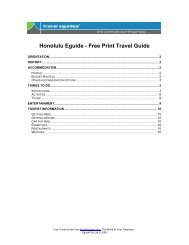Australia Eguide - Travel Guides
Australia Eguide - Travel Guides
Australia Eguide - Travel Guides
You also want an ePaper? Increase the reach of your titles
YUMPU automatically turns print PDFs into web optimized ePapers that Google loves.
187<br />
some prison buildings and some the homes of those operating the prison, or just ordinary<br />
civilians residing in the area. There is also the separate prison, for those who not only<br />
were transported convicts who had committed further offences in <strong>Australia</strong>, but had then<br />
re-offended in Port Arthur. Their punishment was a life of silence and solitary<br />
confinement. Even in church, where they were allowed to sing and pray audibly, in the<br />
hope of some propitious result, they were segregated from their fellow prisoners in<br />
individual stalls.<br />
There is a beautifully built church, and a hospital, where, in fact, patients were well<br />
tended. There is an avenue of trees forming a memorial for those lost in the Great War.<br />
There is a Post Office and a Policeman's Residence reminding us that this was a living<br />
community after its convict days, and even during them.<br />
The admission ticket is valid for two days and includes a harbour cruise, except during<br />
July and August. The cruise lasts for twenty minutes and shows the shipbuilding industry<br />
here, the former boys' prison at the aptly named Point Puer and, from a distance, the Isle<br />
of the Dead, the cemetery for this prison community. A detailed tour of the Isle of the<br />
Dead is offered for an additional charge.<br />
In recent years, Port Arthur made history again, as most visitors know. On 28th April<br />
1996, a man with a semi-automatic rifle opened fire in the cafeteria, and later elsewhere,<br />
killing 35 people and wounding a further eighteen. A mentally impaired 28-year-old from<br />
Hobart, who for months protested his innocence, was eventually tried for the murders and<br />
convicted. The 35 innocent victims are remembered in a Memorial Garden near the<br />
Visitor Centre.<br />
There is, of course, plenty of accommodation in the vicinity of Port Arthur, since it is a<br />
tourist spot rapidly gaining in popularity. Options include a youth hostel in a beautiful<br />
former guest house built in 1890 and just outside the back entrance to the Port Arthur<br />
enclosure, but this is an option which is frequently rather crowded. There is also a<br />
Caravan Park offering a bunkroom for backpackers.<br />
There are other sights to see in the vicinity of Port Arthur. These include Remarkable<br />
Cave, five kilometres south, and various other convict sites. Of the latter the most<br />
interesting is the Coal Mines, in the north-west of the peninsula. Coal was discovered<br />
here in 1833 and, although it was relatively low-grade coal, it gave Tasmania a degree of<br />
independence from New South Wales, from where all supplies had previously been<br />
imported. A contingent of the most refractory prisoners was sent to work these mines, in<br />
very harsh conditions, and another prisoner, one Joseph Lacey, convicted for robbery,<br />
appointed as overseer, since he had experience of mining. He proved so capable in this<br />
position that he eventually became the lessee of another colliery following his release.<br />
There are also the remains of convict ‘probation stations' (outstations) at Nubeena,<br />
Premaydena, Saltwater River, Koonya and Taranna.<br />
Free from <strong>Travel</strong><strong>Eguide</strong>s.com Online <strong>Travel</strong> Information.<br />
©2008 <strong>Eguide</strong> Pty Ltd




